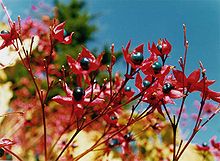Bleeding-heart vine
| Clerodendrum | |
|---|---|
 |
|
| Clerodendrum trichotomum fruit | |
| Scientific classification | |
| Kingdom: | Plantae |
| (unranked): | Angiosperms |
| (unranked): | Eudicots |
| (unranked): | Asterids |
| Order: | Lamiales |
| Family: | Lamiaceae |
| Subfamily: | Teucrioideae |
| Genus: |
Clerodendrum L. |
| Type species | |
|
Clerodendrum infortunatum L. |
|
| Species | |
|
See text |
|
| Synonyms | |
|
Adelosa Blume |
|
See text
Adelosa Blume
Archboldia E.Beer & H.J.Lam
Siphoboea Baill.
Siphonanthus L.
Spironema Hochst.
Clerodendrum is a genus of flowering plants in the family Lamiaceae. Its common names include glorybower, bagflower and bleeding-heart. It is currently classified in the subfamily Ajugoideae, being one of several genera transferred from Verbenaceae to Lamiaceae in the 1990s, based on phylogenetic analysis of morphological and molecular data.
Estimates of the number of species in Clerodendrum vary widely, from about 150 to about 450. This is partly because about 30 species have been transferred to Rotheca, about 30 more to Volkameria, and 1 to Ovieda. The type species for the genus is Clerodendrum infortunatum. It is native to Sri Lanka and the Andaman Islands.
The genus is native to tropical and warm temperate regions of the world, with most of the species occurring in tropical Africa and southern Asia, but with a few in the tropical Americas and northern Australasia, and a few extending north into the temperate zone in eastern Asia.
They are shrubs, lianas, and small trees, usually growing to 1–12 m (3 ft 3 in–39 ft 4 in) tall, with opposite or whorled leaves. C. floribundum can grow to 30 m (98 ft) tall.Clerodendrum fistulosum and Clerodendrum myrmecophila have hollow stems that are inhabited by ants.Clerodendrum trichotomum is a common ornamental in warmer parts of the world. Eight other species are also grown in the tropics for their abundant and attractive flowers. One of these, Clerodendrum macrostegium, suckers abundantly from the roots, often producing a thicket within a few years. A few other species are also found, somewhat rarely, in cultivation.
...
Wikipedia
